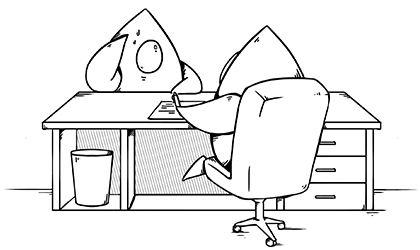In our initial WWDC 2025 recap, we looked at the high-level changes across Apple’s platforms: the unified version numbering (hello, 26), the Liquid Glass interface overhaul, and the sweeping improvements to development tools and AI integration. But no WWDC is complete without the behind-the-scenes chatter from the developers who live and breathe this stuff.
We asked some of the folks at MartianCraft what stood out to them most from this year’s announcements—and they had thoughts. Here’s what some of our team had to say.
Instruments, Concurrency, and a New Way to Think About Threads
“I’m a fan of tooling, and Instruments in particular. The improvements to the SwiftUI and processor trace Instruments in particular are stellar. I also feel the MainActor-isolated-by-default build option, alongside Apple’s suggestion of turning the concurrency problem on its head (i.e., main actor first, focused concurrency additions later) gives engineers a logical and purposeful approach to adoption of strict concurrency.”
— Josh Nozzi, senior iOS developer
SwiftUI Performance Tools, Foundation Models, and Accessible Concurrency
“Like Josh, I’m a big fan of Instruments, and the addition of SwiftUI Performance Instruments is a huge win for developers and will be a big help for tracking down bottlenecks in SwiftUI apps. Pinpointing precise locations in code along with Cause and Effect graphs will be indispensable for moderate to complex app model states. Go check out the Optimize SwiftUI performance with Instruments session.
“Other sessions of interest include Embracing Swift concurrency. This session kept it easy to follow for developers that might be new to Swift concurrency, while diving into enough detail to make it a very helpful session. I especially applaud the approachable concurrency build setting that automatically forces an app to be single-threaded by isolating execution on MainActor. This gives developers the chance to slowly work multithreading into their apps.
“The Meet the Foundation Models framework session provided a high-level overview of the new Foundation Models framework for bringing on-device AI models into your apps. This session is a great introduction, with a list of related sessions including prompt design and code-alongs for getting into specific use cases for this new framework. Pay attention to the new #Playground macro that can be used to test your prompts along with latency testing in Instruments.”
— Brian Buck, senior iOS developer
Swift Containers and the Full Stack Swift Dream
“I still have so much to consume, but one thing that immediately caught my attention was containerization. Apple has open-sourced a Swift Package that allows us to run Linux containers on macOS utilizing the native Virtualization frameworks. It’s entirely written in Swift and uses a design that runs each container in a lightweight virtual machine and follows the Open Container Initiative (OCI) protocols. This strategy should allow for rapid and efficient local development within containers while producing containers that can run in any container environment following OCI protocols.
“As an iOS developer of 16 years with a background in backend server development, I am very excited by the work Apple and the community are doing to make Swift a viable programming language on servers. I’ve had a chance to try out running server-side Swift in containers on Google Cloud Run, and it’s been very fun to learn about. I feel empowered by the idea that I have the ability and confidence to write Swift code on clients as well as on the server—realizing the “full stack developer” dream. Check out the session for more details.”
— Chris Wagner, team lead and senior iOS developer
Xcode, AI, and Foundation Models
“I believe that we’re seeing a turning point in not only how iOS apps are designed but also how they are built. We’re seeing an increasing reliance on LLMs to help with the boilerplate code and aid developers in getting things done better and faster, and Apple seems to be accepting this and finding a way that AI can help developers—but in a way that doesn’t replace them outright. AI is a great tool, but it’s never the end goal—it’s a way to help us build better apps faster, but we still need the human touch, experience, and knowledge of what makes great apps.
“I’m glad to see Apple allow integration with Foundation Models. This will be a game-changer for apps that need to integrate with AI but don’t have the budget or inclination to build with the ChatGPT or Anthropic APIs. Doing simple AI tasks safely and securely on-device will make a lot of apps much better, especially when it comes to transcriptions, classification, and identification of photos, videos, audio, and more. I’m glad that Apple is open to the on-device LLMs, but also happy to see how they are working to integrate with the major players, because while on-device LLMs provide security, they cannot do everything that online models can.”
— Cory Bohon, team lead and senior iOS developer
Xcode + LLMs = Smarter Workflows
“While AI expectations for Apple were muted going into WWDC this year, I think Apple delivered a lot more than I was expecting. In particular, the changes to Xcode bringing LLMs right into the editor were a welcome surprise. Not only is ChatGPT fully baked in, you can add almost any model provider, including those running locally on your own machine. Another welcome addition was the opening of Apple’s own on-device foundation models. With the Foundation Models framework, Apple has made it incredibly easy to do inference and generate structured output. The new #Playground macro also makes it a breeze to test and explore code right where it lives. It’s like #Preview, but for data structures!”
— Josh Levine, senior iOS developer
Liquid Glass and the Evolution of the iPad
“Remember when iOS 7 beta 1 launched? There was a lot of criticism around the ultra-light fonts and UI icons. Legibility suffered. But over the following months, Apple adjusted the visual weight and contrast, finding a more usable middle ground. That’s how Liquid Glass feels after a week of real-world use—promising in many areas, but still a work in progress.
“Good UI is transparent—it disappears into the background so you can focus on your content and the task at hand. Apple’s new Liquid Glass look in iOS 18 might seem like a purely aesthetic choice flexing their software and design capabilities, but the concept goes deeper than that.
“Once you get past the surface-level shimmer, you start to notice the UX enhancements underneath. Tab bars, title bars, and toolbars are more responsive and adaptive. Tab bars dynamically collapse as you scroll, making room for content without requiring full-screen gestures. Toolbars morph between screens to display contextual actions, surfacing controls when needed and fading them when not. These aren’t just visual tricks—they’re interaction refinements that make the OS feel lighter and more alive. It’s not just about looking modern—it feels modern.
“All of this said, I am most excited about the refinements to iPad. Between the file management updates, ease of multitasking, background tasks, and new menu bar, the iPad finally feels like a system worthy of sitting between iOS and macOS.”
— Nick Keppol, creative director
Wrapping It Up
WWDC 2025 delivered more than just platform upgrades and version number changes. It gave developers real tools to work smarter, code faster, and design better apps with greater cross-platform consistency. The takeaways from our team reflect the depth and breadth of this year’s announcements—from AI and Instruments to Swift on the server and the future of UI across Apple’s platforms.
As always, we’re already hard at work integrating these technologies into our apps and client projects. If you’re as excited as we are about what’s next, reach out—we’d love to help you take full advantage of everything Apple’s latest platforms have to offer.


